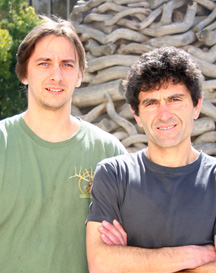

New Technique Clears Path for Developing Drugs and Vaccines for Hemorrhagic Fever Diseases
By Anna Sobkowski
A team from the Scripps Research Institute has developed a novel method for studying arenaviruses, rodent-borne viruses that can cause hemorrhagic fever diseases. Currently, no licensed vaccines are available against arenaviruses and drug therapies are extremely limited. This development opens new avenues for vaccine development and identification of anti-viral drugs to combat human pathogenic arenaviruses.
"The strategy we have developed offers opportunities never before available for studying the gene expression of arenaviruses," says Juan de la Torre, a Scripps Research associate professor who led the research team, which engineered a recombinant form of the arenavirus lymphocytic choriomeningitis virus, called r3LCMV.
The work was published in the February 10, 2009 Early Edition of the Proceedings of the National Academy of Sciences (PNAS).
Some arenaviruses can cause severe disease in humans. For example, Lassa virus causes Lassa fever, a hemorrhagic fever disease endemic to sub-Saharan Africa, whereas other arenaviruses are responsible for a variety of South American hemorrhagic fever diseases. Infections with hemorrhagic fever arenaviruses are characterized by damage to the vascular system, and may be associated with disease symptoms that can be relatively mild, severe or deadly. Victims who recover from their illnesses may suffer post-infection health problems, especially hearing loss in the case of infection with Lassa virus.
While the first arenavirus, lymphocytic choriomeningitis virus (LCMV), was discovered in 1933, new arenaviruses are found every few years. The name arenavirus is derived from the grainy appearance of RNA—"arena" means "sand" in Latin. The prototypic arenavirus LCMV has been instrumental in helping scientists better understand many aspects of virus-host interactions. However, a limitation for investigations aimed at developing novel anti-arenaviral strategies has been the inability—until now—to manipulate the LCMV genome to permit the expression of additional foreign genes to generate recombinant viruses with unique properties.
Engineering the Genome
Arenaviruses are enveloped viruses with a bisegmented negative strand RNA genome and a life cycle restricted to the cell cytoplasm. Each genomic RNA segment, called L and S, codes for two different gene products that are synthesized in opposite directions, which is known as "ambisense" strategy. The L RNA encodes the viral RNA- dependent RNA polymerase and viral matrix protein involved in assembly and virus release from infected cells. The S RNA encodes the viral surface glycoprotein (GP) and the nucleoprotein (NP). De la Torre and colleagues reasoned that the strict requirement of GP and NP for production of infectious LCMV would pose a strong positive selective pressure to facilitate the generation of a recombinant LCMV containing 1 L and 2 S segments, where each S segment was altered to replace one of the viral gene products, NP or GP, by a gene of interest. This trisegmented LCMV—r3LCMV—would permit the expression of two additional foreign genes under the control of LCMV gene expression.
"With the tri-segmented approach, we have created viruses that can directly express foreign genes," de la Torre says, adding that he was initially skeptical that these viruses would be robust. "It now will be possible to use r3LCMV expressing appropriate reporter genes to develop high-throughput screening assays to identify anti-viral drugs that inhibit arenavirus replication. This is the first time this has been done with arenaviruses."
In addition to screening for drugs with virus-killing properties, this new trisegmented technique allows the creation of viruses that are highly attenuated—or live—but don't actually cause disease. Mice inoculated with this attenuated r3LCMV do not exhibit any noticeable clinical symptoms but elicit a protective immune response against challenge with a wild type LCMV. This approach is similar to what occurs with the live polio vaccine. Because the trisegmented viruses grow well in culture, it may now be possible to create r3LCMV that expresses specific antigens for vaccine purposes.
"Many basic concepts in viral immunology resulted from the study of LCMV, such as how T cells can clear the virus, and how viruses escape from T cell recognition," de la Torre says. "The ability to genetically manipulate LCMV opens up tremendous possibilities for discovering the molecular basis of many of these processes."
In addition to de la Torre, co-authors of the paper, "Generation of recombinant lymphocytic choriomeningitis viruses with trisegmented genomes stably expressing two additional genes of interest," are Sebastien Emonet, Lucile Garidou, and Dorian McGavern of Scripps Research. See http://www.pnas.org/content/early/2009/02/10/0900088106.abstract.
The work was supported by the National Institutes of Health, the Burroughs Wellcome Fund, and the Délégation Générale pour l'Armement.
Send comments to: mikaono[at]scripps.edu

"The strategy we have developed offers opportunities never before available for studying the gene expression of arenaviruses," says Associate Professor Juan de la Torre (right), shown here with Research Associate Sebastien Emonet.
